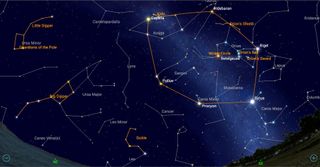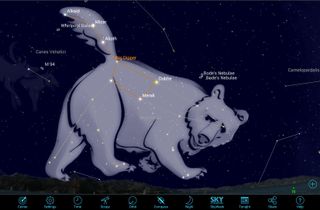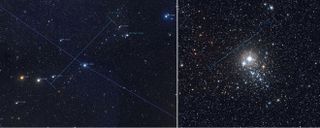Catch the 'Winter Football' and Other Asterisms with Mobile Astronomy Apps

Constellations have long been used to organize the night sky and capture our imaginations with their myths and legends. But only a limited number of constellations resemble their name, and the stars making up their dimmer elements are increasingly hard to see under light-polluted skies. Asterisms, on the other hand, are easy-to-see star patterns that add an element of fun to skywatching because they are so accessible to beginners. And you're free to imagine your own!
Just in time for next week's big game, one of the largest asterisms in the night sky, called the Winter Football, is perfectly positioned for viewing by just stepping outside and looking up.
In this edition of Mobile Stargazing, we'll tell you how to see the Winter Football and highlight a few other asterisms that are visible with unaided eyes, in binoculars and in small telescopes with the help of mobile astronomy apps. [Best Binoculars for Earth and Sky]
Asterisms versus constellations
For millennia, skywatchers have visualized patterns in the stars, connecting the dots to form stick figures. They shared their impressions with members of their communities, passed them down through the generations, and created myths and legends to accompany the figures in the sky. Some star patterns were so obvious that cultures around the world independently saw the same thing. Leo the lion, Orion the hunter and Scorpius the scorpion are prime examples of this. Other societies saw arrangements of stars forming objects, birds or animals familiar only to them. Some astronomy apps, including SkySafari 6 and Stellarium Mobile, can display the constellations of different cultures.
The roots of our modern constellations began in ancient Greece during the second century B.C., when the astronomer Hipparchus created a list of 48 classical constellations in common use, many of which originated with the ancient Babylonians. Ptolemy, another Greek astronomer, included them in his Almagest, a star catalog that he published a few decades later. The Almagest constellations were widely adopted by Europeans, who expanded the set with additional minor constellations over the next 1,800 years. In the 16th century A.D., seafaring explorers encountered parts of the southern sky never before seen and added 14 new constellations to the list.
In the 1930s, in an effort to standardize astronomy worldwide, the International Astronomical Union (IAU) formally recognized 88 constellations, each with a defined boundary that left no gaps in the sky coverage. Thus, every object in the sky was located within a home constellation.
Get the Space.com Newsletter
Breaking space news, the latest updates on rocket launches, skywatching events and more!

The constellation labels and boundaries in mobile astronomy apps follow the IAU system. Interestingly, the way the "stick figures" are created by joining the stars is not standardized, and many astronomy apps offer multiple options to portray the constellations. In 1954, H.A. Rey, author of the "Curious George" books, wrote a charming illustrated-children's book called "Find the Constellations," and a more advanced book called "The Stars: A New Way to See Them." (Updated versions are still in print.) Rey drew the constellations in new and whimsical ways, often making them much more obvious. The SkySafari6 app shows Rey's portrayals in the Modern Constellations Settings option. Stellarium desktop software includes them, too, under the Starlore settings.
Asterisms are informal star patterns not governed by the IAU. They are usually composed of brighter stars taken from a larger constellation or assembled from multiple adjacent constellations. Their names are informal, too — so some are known by more than one name. Large asterisms tend to be easier to see than constellations because of their brighter stars. Learning to identify asterisms is fun and makes a terrific starting point for learning the night sky in more detail.
Below, we'll highlight a few of the best asterisms visible during winter from the Northern Hemisphere. I'll highlight some for unaided eyes, some for binoculars, and a few of the multitude of small ones only visible in a telescope. You can use the constellations and star names that I mention to find them with your astronomy app. In the Asterisms Display section of the Constellations Settings menu in SkySafari 6, you can switch on the asterisms and their names. They'll be plotted with a different color on top of the regular constellations. You can also turn off the constellations and leave only the asterisms. [Winter Skywatching: Spot Some Overlooked Constellations]
Two good web resources for lists of asterisms are the Astronomical League's Asterism Observing List and Demelza Ramakers' Asterisms page. Small asterisms are ideal targets for telescope owners during bright moonlit nights when other objects are washed out.
One last point to ponder. The bright planets move among the stars and can "invade" or confuse an asterism from time to time. Since there are no naked-eye planets in the evening sky this winter, they won't bother us. Let's start with the big one!

The Winter Football
If you've been out under clear skies lately, you can't have missed the sprinkling of incredibly bright and colorful stars in the southern evening sky. Some of the brightest stars form a huge six-sided asterism called the Winter Hexagon or Winter Circle. But — in time for next week's big game — I prefer to think of it as the Winter Football!
In early evening the football is standing upright with the lower point just above the southeastern horizon. The asterism is 65 degrees high (or 6.5 fist diameters held at arm's length) and 45 degrees wide. Let's trace it out.
Starting at the bottom tip of the football, the very bright, white star that is fairly low in the sky is Sirius, nicknamed the Dog Star, in the constellation of Canis Major (the Big Dog). Moving counter-clockwise (westward), the next star is bright, blue-white Rigel. It sits 23 degrees above and to the right of Sirius and marks the western foot of Orion.
Almost three fist diameters above Rigel is the bright orange star Aldebaran, which marks the angry eye of Taurus the Bull. Aldebaran is an old red giant star more that 40 times the diameter of our sun. Located between Rigel and Aldebaran, but offset to the left (east), is the bright reddish star Betelgeuse, which sits at Orion's eastern shoulder. This star is a true giant — believed to be more than 600 times the size of the sun! If you like, you can turn the Winter Football into a capital "G" by using Betelgeuse to form the horizontal line in the letter.
At the upper tip of the football is bright yellow Capella, the Goat Star. It sits nearly overhead in the constellation of Auriga the Charioteer. Auriga is more or less a ring of medium-bright stars with Capella at the top as the "diamond." Next, moving three fist diameters down and to the left of Capella we encounter a pair of nearly identical bright stars separated by only a few finger widths: the twins Castor (upper) and Pollux (lower) in the zodiac constellation of Gemini. The bodies of the twins extend toward Orion. Finally, look midway between Castor and Pollux and Sirius for the final star in the asterism, bright blue-white star Procyon in Canis Minor (the Little Dog). Sirius and Procyon are both located less than 12 light-years from Earth — practically in our backyard. That's one reason why they shine so brightly!
Like all asterisms, the Winter Football is visible on the same dates and times every year. It will be visible from now until midspring. This weekend, the moon will cross through the hexagon from Friday to Monday.

The Big Dipper and other large northern asterisms
Contrary to popular belief, the Big Dipper is not a constellation. It's an asterism made from part of the larger constellation Ursa Major, the Big Bear. The Big Dipper's seven bright stars — a flat-bottomed basin attached to a bent three-starred handle — are circumpolar, making it visible year-round from mid- northern latitudes. The handle is also the crooked tail of the bear. The basin is its rear torso. The front half of the bear extends 18 degrees beyond Dubhe, the star at the Big Dipper's outer rim. The bear's legs and feet are below and in front of the Big Dipper. All of the non-Dipper stars in the constellation are dimmer, making the Big Dipper stand out. The Little Dipper, which sits above the Big Dipper, is considered both an asterism and a constellation. [Big Dipper Stars Shine Over Stargazer in Amazing Photo]
Another fine winter naked-eye asterism is the Great Square of Pegasus. It reminds me of a baseball diamond because one corner is usually pointed downward. The asterism is about 15 degrees across and can be seen over the western horizon until midevening.
The three stars in Orion's belt count as an asterism, too. When viewed from the Southern Hemisphere, Orion is upside down. His sword, which then appears just above his belt, combines with the three belt stars to form an asterism called the Frying Pan. To see it, try looking at Orion upside down!
Finally, about 8 p.m. in your local time, the distinctive constellation of Leo the Lion rises in the east. While the entire constellation might be considered an asterism, his head and neck stars form a backward question mark, called the Sickle asterism.

Telescope and binocular asterisms
Some asterisms are smaller, forming whimsical shapes best seen in binoculars and telescopes. Here are a few winter asterisms to hunt for using your astronomy app. I've included some formal designations that you can use when searching in your app.
The Trapezium is a small quartet of stars buried in the heart of the Orion Nebula (Messier 42). Using you telescope, enlarge the nebula until you can see the small trapezoid-shaped asterism inside. These young stars are helping to make the nebula glow.
Use binoculars to see a large "S"-shape asterism between Alnilam and Mintaka, two westernmost stars in Orion's belt. It's about 2 degrees, or two finger widths, tall.
The Pleiades (Messier 45) is a naked-eye asterism located above the triangular face of Taurus in the evening southeastern sky (just outside of the Winter Football). This small bright cluster of bluish stars often reminds skywatchers of the Little Dipper because of its similar shape. It is associated with the Daughters of Atlas from Greek mythology, and is used as the logo for Subaru. Because it is too large for most telescopes, use binoculars for the best view.
The ET Cluster (NGC 457), also known as the Owl Cluster or Dragonfly Cluster, is one of my favorite asterisms. It is located high in the northwestern evening sky in Cassiopeia. It features two bright yellow "star-eyes" above a sprinkling of stars making a stubby body, and chains of stars forming two curved upswept wings. The shape is too small to make out in binoculars, but viewing it in a backyard telescope at low power will delight you.
Kemble's Cascade is a 2.5-degree long line of faint stars within the constellation of Camelopardalis. It terminates near a star cluster designated NGC 1502. In winter evenings, the chain is located nearly overhead in the northern sky. The line is oriented horizontally at 7 p.m. local time and rotates more vertically every hour. Use binoculars to find it, and then sweep along the chain using your telescope.

Going beyond: More asterisms to hunt for
Other asterisms, such as the Southern Cross, are only visible from the Southern Hemisphere. When traveling, it's fun to ask local skywatchers to point out the asterisms they know. From home, different asterisms appear at different times of the year. Here are some asterisms you can seek out, with their main constellations abbreviated in parentheses: Coathangar (Vul), Teapot (Sag), Summer Triangle (Lyr, Cyg, Alt), Northern Cross (Cyg), Fish Hook (Sco), Kite (Boo), Keystone (Her) and Job's Coffin (Del). Use your app to find out whether they are available in your sky and when to see them.
We've just scratched the surface. Enjoy the Winter Football and remember that asterisms are unofficial — so you are free to imagine your own. But don't be surprised if someone hasn't already had the same idea. In future editions of Mobile Stargazing, we'll look at measuring distances to stars, seeing stars mentioned in science fiction and more. In the meantime, keep looking up!
Editor's note: Chris Vaughan is an astronomy public outreach and education specialist at AstroGeo, a member of the Royal Astronomical Society of Canada, and an operator of the historic 74-inch (1.88-meter) David Dunlap Observatory telescope. You can reach him via email, and follow him on Twitter @astrogeoguy, as well as on Facebook and Tumblr.
This article was provided by Simulation Curriculum, the leader in space science curriculum solutions and the makers of the SkySafari app for Android and iOS. Follow SkySafari on Twitter @SkySafariAstro. Follow us @Spacedotcom, Facebook and Google+. Original article on Space.com.
Join our Space Forums to keep talking space on the latest missions, night sky and more! And if you have a news tip, correction or comment, let us know at: community@space.com.
Chris Vaughan, aka @astrogeoguy, is an award-winning astronomer and Earth scientist with Astrogeo.ca, based near Toronto, Canada. He is a member of the Royal Astronomical Society of Canada and hosts their Insider's Guide to the Galaxy webcasts on YouTube. An avid visual astronomer, Chris operates the historic 74˝ telescope at the David Dunlap Observatory. He frequently organizes local star parties and solar astronomy sessions, and regularly delivers presentations about astronomy and Earth and planetary science, to students and the public in his Digital Starlab portable planetarium. His weekly Astronomy Skylights blog at www.AstroGeo.ca is enjoyed by readers worldwide. He is a regular contributor to SkyNews magazine, writes the monthly Night Sky Calendar for Space.com in cooperation with Simulation Curriculum, the creators of Starry Night and SkySafari, and content for several popular astronomy apps. His book "110 Things to See with a Telescope", was released in 2021.


